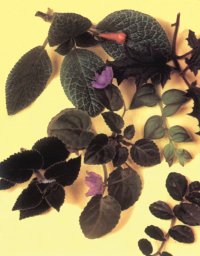Most house plant enthusiasts enjoy the challenge of multiplying their plants, either to renew them or to have new plants to use as gifts. Not all the methods shown here apply to each house plant, but all can be propagated in one manner or another.
Stem Cuttings
Stem cuttings are the most popular method of plant propagation. The technique can be applied to all plants with noticeable stems. Select a healthy section of stem with at least three nodes (the bumps or rings where a leaf is or was attached) and cut it cleanly with a sharp knife just below the lowest node. Remove any flowers or flower buds as well as any leaves growing from the bottom node. A rooting hormone, available in the form of a powder, gel, or liquid, can be applied to the cut section. While not absolutely necessary, it can help stimulate faster rooting.

Stem cuttings are the most popular
method of plant propagation.
|
Cuttings can be rooted in water, but it is best to use a pasteurized rooting mix such as soilless growing media, vermiculite, sand, or perlite. Fill a pot or other container with mix and moisten it lightly.
Use a pencil to prepare a hole for the stem, then insert the cutting so that at least one node, and preferably two, are covered with mix. Firm the mix, then cover the container with a clear plastic bag to maintain high humidity, which is necessary to keep the young cutting from wilting.
Put the cutting in bright light, but not full sun, and supply warm temperatures. When the plant is well rooted and growing on its own (this can take from two weeks to several months), remove the plastic and treat the cutting like an adult plant.
Once the top section of stem cutting has been removed, the rest of the stem can be cut up into sections and also rooted. Just make sure not to invert stem cuttings. They must be right-side up in order to root.
Cuttings of succulents and cacti should be allowed to heal over before being potted, a process that can take anywhere from several days to more than a month. Don’t cover succulents with plastic since high humidity can cause them to rot.
Leaf Cuttings
Only a few plants can be reproduced by leaf cuttings, but their ease of propagation makes them very popular house plants, Break off a whole leaf, including its stalk, and insert the stalk into the rooting medium as above, covering the container with clear plastic. One or more new plantlets will soon sprout at the leaf’s base. They can be potted individually when they are well rooted.
In the case of a few plants (florist’s gloxinias, rex begonias, snake plants, and streptocarpus), even a small leaf section can be rooted. Cut a healthy leaf into sections, each one with a major vein, and place each section so its base is just barely covered with mix. New plantlets will soon appear.
Layering
This method applies mainly to plants with trailing stems or to those, like the spider plant, that produce baby plants on stolons. Simply set a pot filled with moist growing mix under a section of stem and pin it down to the mix with a hairpin or twist tie. When the attached section has rooted, cut it free from the mother plant and grow it on its own. Among the plants that can be propagated by this method are hare’s foot ferns, episcias, pothos, Boston ferns, and strawberry begonias.
Air Layering
The air layering method is used on trees or shrublike plants, often those with thick or woody stems that are hard to root from stem cuttings. Using a sharp knife, make a cut halfway through the main stem, about one third of the way down from the growing tip. Insert a sliver of wood or a match into the cutting to prevent it from healing over. Apply a small amount of rooting compound to the cut, then cover it with a handful of moist sphagnum moss. Wrap the moss in a sheet of plastic and attach the plastic to the stem with twist ties. Check the moss every week or so and add water if it dries out. When roots have formed, pot the new plant in an individual pot and treat it as an adult plant.
Division
Plants that grow in clumps are best propagated by division. Remove the plant from its pot and break the rootball up into sections, each with at least one rooted stem, using a knife if necessary. Plant the divisions in individual pots.
Certain plants produce offsets -- baby plants at the base of the mother plant. These can be cut free from the mother plant when they reach about one third of their size. At this point, most are well rooted and can be treated as any newly potted plant. If they are not rooted, treat them as cuttings.
Seed
Almost all house plants can be grown from seed, although seeds may be hard to come by. It is easiest to buy them from seed companies, but some plants will also produce seeds on their own.
Sprinkle the seeds over the surface of a moist growing medium and press lightly. Large seeds should be covered with a thin layer of potting mix. Cover the container with clear plastic or a sheet of glass and place it in a warm, brightly lit spot. When plantlets appear and have formed at least four true leaves, harden them off by gradually removing their protective covering, and pot them individually in small pots. Plants easily propagated by seed are asparagus ferns, begonias, primroses, and parlor palms.
In the next section, we'll talk about decorating with house plants.
Want to learn about house plants by type? Try these:










